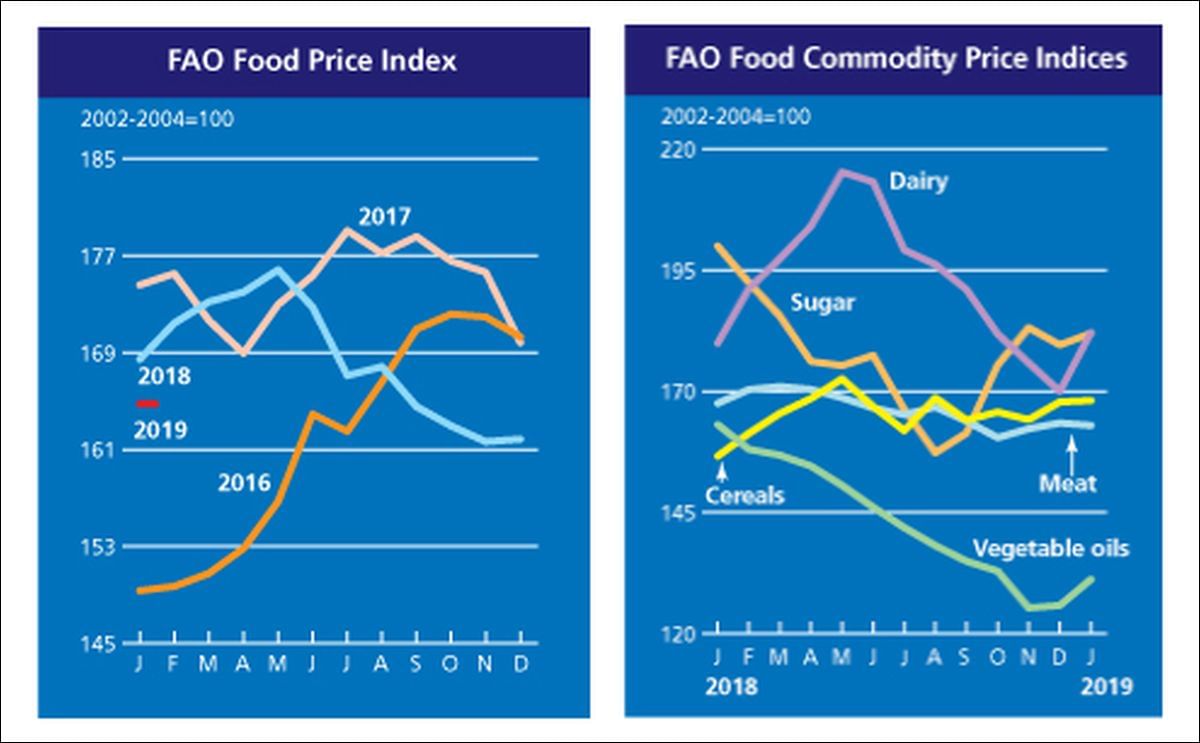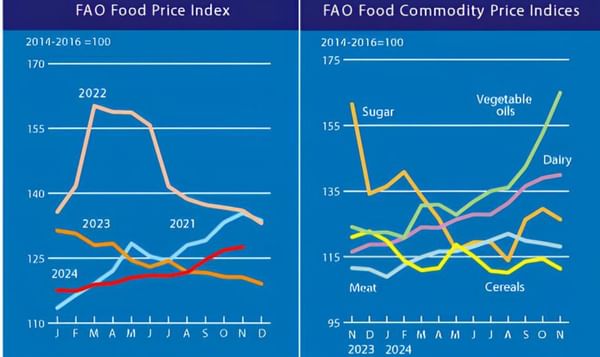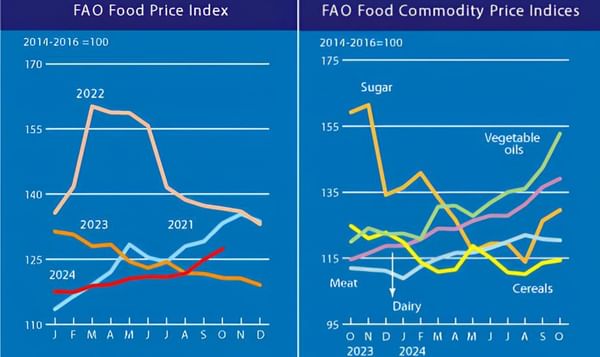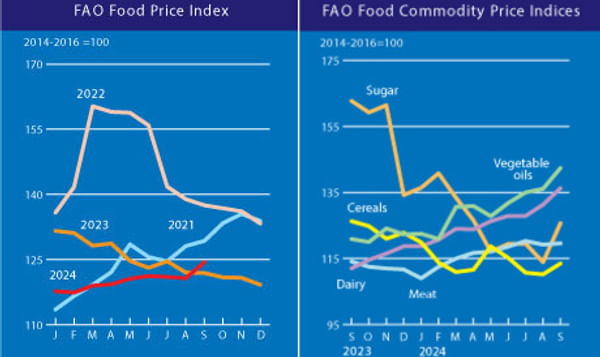The FAO Food Price Index (FFPI) averaged 164.8 points in January 2019, up almost 3 points (1.8 percent) from December 2018 but still 3.7 points (2.2 percent) below the corresponding month last year.
The FAO Food Price Index started the new year on firmer ground

The FAO Food Price Index (FFPI) averaged 164.8 points in January 2019, up almost 3 points (1.8 percent) from December 2018 but still 3.7 points (2.2 percent) below the corresponding month last year.
After three successive months of relatively stable levels, the increase in January was largely driven by a sharp rebound in dairy price quotations as well as firmer prices of vegetable oils and sugar.
The FAO Cereal Price Index averaged 168.1 points in January, up marginally from December and almost 11.5 points (7.3 percent) above its January 2018 level.
Except for rice, the prices of other major cereals remained generally firm, supported by the decline in global production in 2018, tightening export supplies and robust world demand. January, however, was a particularly quiet month for wheat and maize markets, in part due to the absence of several key reports in the United States because of the US Government shutdown.
Nonetheless, grain prices were up during the month, with maize values rising the most, in reaction to adverse weather conditions in South America. International rice prices also increased, primarily owing to upbeat demand for Japonica supplies and a firmer Thai Baht.
The FAO Vegetable Oil Price Index averaged 131.2 points in January, rising 5.4 points (or 4.3 percent) from the previous month and marking the second consecutive increase after a protracted fall.
The rise mainly reflects additional gains in palm oil values, underpinned by a seasonal decline of production in the major producing countries and a firm global import demand. International soyoil prices also rose, largely reflecting robust demand for South American supplies.
The FAO Meat Price Index averaged 162.9 points in January, almost unchanged from December 2018.
In view of the non-availability of data from official sources in the United States because of the Government shutdown, the January value of the Index was calculated assuming stable prices for meat products in the United States. Elsewhere, international price quotations for bovine, pig and poultry meat remained steady. However, ovine meat prices declined by as much as 8.4 percent month-on-month, pressured by ample exportable supplies in Oceania.
The FAO Dairy Price Index averaged 182.1 points in January, up 12.2 points (7.2 percent) from December 2018.
The sharp rebound followed seven months of falling prices. All dairy products represented in the index registered higher prices in January, with Skim Milk Powder (SMP) quotations rising by as much as 16.5 percent month-on-month. The sharp increase resulted from limited export supplies from Europe, due to strong internal demand, and expectations of a seasonal tightening of export availability from Oceania in the coming months. Notwithstanding this price rise, the Index is only slightly above its level in the corresponding month last year.
The FAO Sugar Price Index averaged 181.9 points in January 2019, up 2.4 points (1.3 percent) from December 2018.
International sugar prices were largely influenced by movements in the Brazilian currency (Real), which gained strength against the United States dollar. A stronger Real supports sugar prices because it limits the supply of Brazilian sugar to the world market, as domestic producers process sugarcane into ethanol for local sale. Firmer crude oil prices lent further support to international sugar price quotations.
After three successive months of relatively stable levels, the increase in January was largely driven by a sharp rebound in dairy price quotations as well as firmer prices of vegetable oils and sugar.
The FAO Cereal Price Index averaged 168.1 points in January, up marginally from December and almost 11.5 points (7.3 percent) above its January 2018 level.
Except for rice, the prices of other major cereals remained generally firm, supported by the decline in global production in 2018, tightening export supplies and robust world demand. January, however, was a particularly quiet month for wheat and maize markets, in part due to the absence of several key reports in the United States because of the US Government shutdown.
Nonetheless, grain prices were up during the month, with maize values rising the most, in reaction to adverse weather conditions in South America. International rice prices also increased, primarily owing to upbeat demand for Japonica supplies and a firmer Thai Baht.
The FAO Vegetable Oil Price Index averaged 131.2 points in January, rising 5.4 points (or 4.3 percent) from the previous month and marking the second consecutive increase after a protracted fall.
The rise mainly reflects additional gains in palm oil values, underpinned by a seasonal decline of production in the major producing countries and a firm global import demand. International soyoil prices also rose, largely reflecting robust demand for South American supplies.
The FAO Meat Price Index averaged 162.9 points in January, almost unchanged from December 2018.
In view of the non-availability of data from official sources in the United States because of the Government shutdown, the January value of the Index was calculated assuming stable prices for meat products in the United States. Elsewhere, international price quotations for bovine, pig and poultry meat remained steady. However, ovine meat prices declined by as much as 8.4 percent month-on-month, pressured by ample exportable supplies in Oceania.
The FAO Dairy Price Index averaged 182.1 points in January, up 12.2 points (7.2 percent) from December 2018.
The sharp rebound followed seven months of falling prices. All dairy products represented in the index registered higher prices in January, with Skim Milk Powder (SMP) quotations rising by as much as 16.5 percent month-on-month. The sharp increase resulted from limited export supplies from Europe, due to strong internal demand, and expectations of a seasonal tightening of export availability from Oceania in the coming months. Notwithstanding this price rise, the Index is only slightly above its level in the corresponding month last year.
The FAO Sugar Price Index averaged 181.9 points in January 2019, up 2.4 points (1.3 percent) from December 2018.
International sugar prices were largely influenced by movements in the Brazilian currency (Real), which gained strength against the United States dollar. A stronger Real supports sugar prices because it limits the supply of Brazilian sugar to the world market, as domestic producers process sugarcane into ethanol for local sale. Firmer crude oil prices lent further support to international sugar price quotations.
Like to receive news like this by email? Join and Subscribe!
Join Our Telegram Channel for regular updates!
精选企业
Sponsored Content
Sponsored Content
Sponsored Content
Sponsored Content
Sponsored Content











